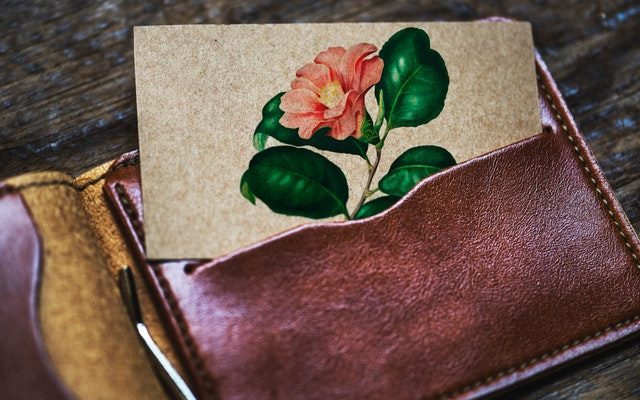
How to Clean and Care for Your Leather Wallet
How to Clean and Care for Your Leather Wallet
Leather wallets are popular as they easily conceal stains and dirt, look stylish and when cared for, can last a lifetime. But how do you maintain their elegant look? What happens when you accidentally drop your wallet in mud or spill food on it? Since you can’t wash it using a dry cleaner, here are some cleaning tips you can use to keep your leather wallet shiny.
Products you should never use on leather
To preserve your leather wallet, you should avoid cleansers with ammonia, bleach, brushes, petroleum, paper towels or even rough clothes. Petroleum-based products usually clog the pores of the hide, and bleach cleansers can cause the wallet’s surface to dry out. Rough cloths can scratch your wallet.
You should use natural sponges or wet cloths to clean your wallet. Avoid dyed products as they can stain the wallet. Remember to always use the right products because using the wrong cleansers can cause your leather to crack and split.
You also want to avoid using excess water when cleaning your wallet. Water can easily soak into the leather and cause unwanted stains. Instead of soaking your wallet in water, it is best to use a sponge to clean its surface evenly.
Materials needed to clean your wallet
- Dry sponge
- Distilled water
- Oil-based leather conditioner
- Bowl or a small pail
- A soft cloth or microfiber towel
- Bowl or a small pail
To start, you need to mix soap and olive oil in a bowl and then apply it on a soft hand towel or dry sponge. Alternatively, you can use white vinegar. To avoid staining the leather, apply the solution on a small spot and check if the leather changes colour.
Apply the solution evenly on the wallets’ surface and use a damp towel to remove all spots. Rinse the towel and wipe the remaining soap residue. Again, remember to ensure you don’t use a lot of water as this can damage the leather. Use a sponge or new cloth to dry out the wallet. When the wallet is completely dry, you can polish its surface using olive oil.
Removing Stains
The process mentioned above may not remove all the stains. Some solutions to treat common stains are as follows.
Ink Stains
Use a nail polish remover or rubbing alcohol. These household products can remove ink marks successfully. Dip a sponge in rubbing alcohol and apply on the stain lightly. Repeat this process until the stain disappears. Use a damp cloth to wipe the area and dry it using a soft towel. You can read more about removing ink stains here.
Grease and oil stains
To get rid of oil or grease spots, you can apply cornstarch or baking soda. Leave the wallet in the mixture overnight. A mixture of either cornstarch or baking soda will absorb the oil stains. Use a soft cloth to remove the remaining powder residues. To remove older stains, apply a solution of cornstarch on your fingers and rub on the stain repeatedly. This process creates friction which in turn absorbs the oil. Brush off the resultant powder and then apply conditioner.
General Stains
Use lemon juice for general stains or use cream of tartar to remove stains from light-coloured wallets. Simply apply the solution on the stain and leave it for an hour. Remove the resultant mixture with a damp cloth and then apply conditioner.
Cocoa Butter, Almond Oil, and Beeswax
Mix these ingredients evenly in a bowl and warm them until they melt and form a paste. Once the solution cools down, massage the stain repeatedly using your fingers. Wipe off the excess using a soft cloth.
White Leather Stain Removal
Mix vinegar and olive oil evenly in a bowl. Apply the mixture on the stain and leave it for ten minutes. Use a damp cloth to wipe it off and apply conditioner.
Linseed Oil and White Vinegar
Mix white vinegar with flaxseed or flax oil and let the mixture rest for 10 hours. Apply the mixture evenly on the leather using a soft cloth, then wipe off any excess using a soft cloth.
Water Damage Recovery
Water can easily damage your leather wallet but there are great dying methods you can try when your wallet gets soaked. You need to dry the wallet with a soft cloth. Stuff it with tissue paper to help prevent the material from shrinking. Avoid hanging your wallet as this may distort its shape.
Extending the Life of Your Wallet
- Don’t overload your walletYour wallet will stretch when you overload it with bills and cards. When you overstuff your wallet, pockets become looser and you may end up replacing it with a new one. If you can fit extra bills, great? But if it can’t, avoid forcing it.
- Never sit on your walletMost wallet designs today are slimmer and pocket-friendly. To prevent altering the shape of your wallet, you should practice keeping it at the front pocket.
Emergency care for your leather wallet
When your wallet falls in the water, never use a hairdryer or dry it over a heater. Let it dry out naturally at room temperature as excessive heat can damage your wallet, deforming its shape entirely.
Use a damp cloth to wipe debris or dirt from your wallet. Never use cleansers or soaps, as chemicals can easily damage the leather not to mention they are tougher to remove.
Leather wallets usually stretch after cleaning them. You should treat your wallet with a natural moisturizer during the cleaning process for prolonged longevity. To ensure you maintain its original shape after cleaning, massage it repeatedly during the drying process.
Be extra cautious when cleaning your leather wallet. Leather is always prone to react adversely with most household cleaners. Also, ensure you don’t over-wet the wallet when cleaning and apply the right moisturizer to extend its longevity. Last but not least, avoid overstuffing your wallet.














